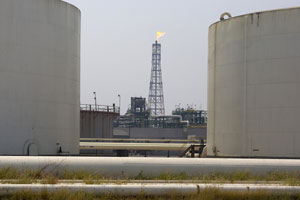US Crude Posts Biggest Monthly Fall Since 2008

U.S. crude posted its biggest monthly drop since the 2008 financial crisis on July 31 after a string of losses in July triggered by China's stock market slump and signs that top Middle East producers were pumping crude at record levels.
A higher U.S. oil rig count for a second straight week added to the market's downside July 31 despite a weaker dollar, which would normally support commodities.
Heavy hedging activity in gasoline and diesel futures ahead of front-month contract expiration dominated play on the petroleum complex, diverting some attention from crude.
Oil prices fell for a fifth straight week.
U.S. crude settled down $1.40, or almost 3%, at $47.32 a barrel. It slid more than 2% on the week.
Through July, U.S. crude was down 21%, its largest monthly decline since October 2008, when oil had an epic collapse at the outbreak of the financial crisis.
Brent settled down $1.10, or 2%, at $52.21 a barrel. It lost 5% on the week and 18% on the month.
The sell-off continued in post-settlement, with both U.S. crude and Brent down more than 3%.
July's oil-price drop was spurred by a stock market tumble in top energy consumer China and growing global oversupply.
A Reuters survey on July 31 showed the Organization of the Petroleum Exporting Countries, which includes Saudi Arabia and other big Middle East producers, pumped more than 32 million barrels per day in July, up 140,000 barrels a day in June.
Bank of America Merrill Lynch said in a note Brent could be at a discount to the benchmark U.S. light crude, West Texas Intermediate, by spring next year, if U.S. gasoline demand remained on a tear. Brent is now at nearly a $5 premium to WTI.
"The European refining system is not geared towards gasoline and neither are medium sour barrels," it said. "As such, WTI may have to temporarily trade above Brent and Dubai next spring to ensure there is enough gasoline to go around."
Industry firm Baker Hughes, meanwhile, said U.S. drillers added five oil rigs this week on top of 21 last week.
Higher rig counts worry the market as they indicate more output. U.S. government data on July 31 showed production dipped in May before rising again in June.




